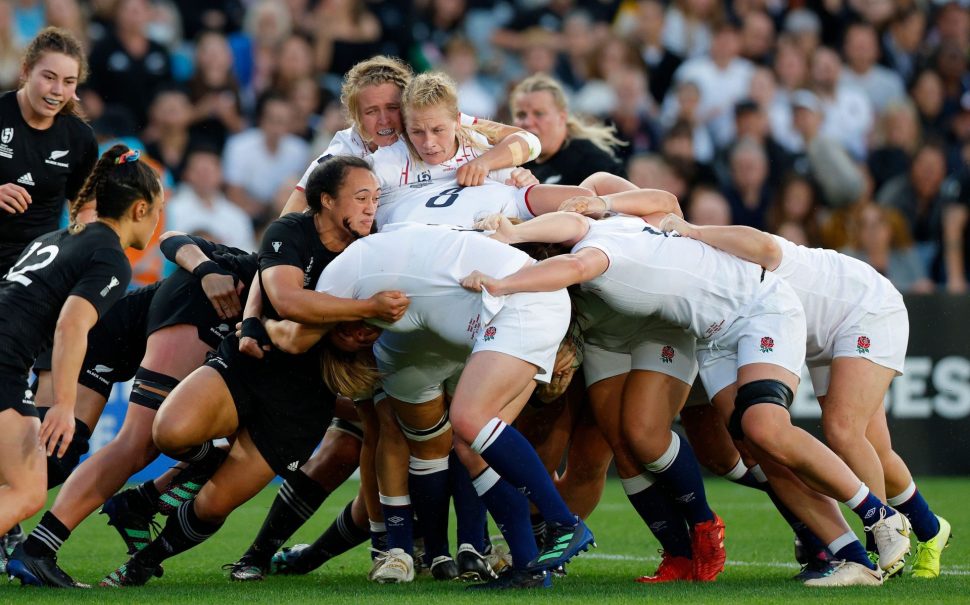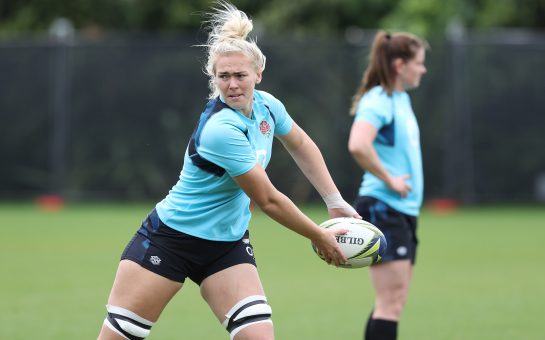It was heartbreak for England on Saturday as New Zealand held onto a three-point lead in the final of the Rugby World Cup and successfully defended their world title on home soil.
The Red Roses’ record-breaking winning streak had to come to an end eventually, and it did so at 30 games in a row.
But this 34-31 epic final battle was worthy of being the one that halted the stampede.
In front of a sold-out Eden Park crowd of 42,579, New Zealand and England put on a performance that will irrevocably change the way women’s rugby is thought of around the world.
Nevertheless, a strong opening quarter wasn’t enough for the Roses to secure a win after Lydia Thompson’s red card in the 18th minute became the defining moment of this World Cup final.
There was a before and there was an after.
From the kick-off England looked to play edge to edge, stretching the Kiwi defence in a way that contradicted how many predicted they would play.
Quick ball from scrum-half Lucy Packer allowed the English pods to gain momentum before sending it wide for Ellie Kildunne to finish in the corner just three minutes in.
Emily Scarratt successfully converted and England were off the ground.
The contrasting tactical styles were beginning to show.
Zoe Harrison executed England’s territorial kicking plan well, pinning New Zealand back in the corners and stifling their favoured running attack.
Pressure eventually compounded for New Zealand as a penalty left the door open for England to kick for a lineout in the 12th minute.
A classically devilish Roses maul ensued and Amy Cokayne dived over to take her first of three scores.
After a shaky boot in previous rounds, Scarratt rose to the occasion once again adding the extras.
Moments away from drama, New Zealand unleashed their backline and Portia Woodman made an expert break down the edge.
Thompson came across to make the cover tackle and direct head-to-head contact put Woodman out cold on the side-line as play continued.
TMO review left no room for mitigation – Thompson made no effort to change her body height and accelerated upwards, a textbook red.
In the 18th minute, England had lost a player in the exact channel New Zealand are most dominant at exploiting.
It would now take every ounce of skill acquired over their three years of professionalism to stay in this battle.
The Roses were clearly shaken by the prospect as the Ferns wasted no time in driving their lineout across the whitewash to register their first try.
England would have to play for 60 minutes with 14 players and only a seven-point lead – a nearly insurmountable task.
The battle was shown to be truly on, however, as the world number ones pounced on a dropped restart to produce another mauling try – this time by Marlie Packer.
England threw down the mantle with this try and prompted New Zealand to respond again in what would become a game of tit-for-tat.
The missing woman on the edge was evident as New Zealand put it wide and Ayesha Leti I’iga ran through acres of open space for her team’s second try.
It seems that England entered this showdown looking to contradict the assumption they would lead with their forwards and set-pieces.
But with a key winger gone, they resorted to their pack again and it became apparent that if England were going to contend they would need to rely on winning in the areas they had numerical matching.
Yet again, their physicality up front dominated in the maul and Cokayne emerged from the pile with the second of her three tries.
In the final minute of the first half, the Black Ferns hit back proving they could maul too as Amy Rule helped close the gap to 19-26 going into halftime.
Come the start of the second half England had opted to make a decision that would be questioned in light of the final result: Middleton took captain Sarah Hunter off the field.
At a time when level-headed leadership and game management were paramount, the Roses had voluntarily lost their rudder.
Add to this that Lucy Packer was brought into the line-up in the 11th hour after staple scrum-half Leanne Infante pulled up with a knee injury, and England were playing the second half of a World Cup final without hugely important player makers.
New Zealand burst out the gate with vigour as Stacey Fluhler offered a brilliant dummy switch that sold Scarratt for a split second.
It was long enough for the centre to link with Renee Holmes before finishing what she started.
The conversion was missed, saving England from being tied in the 42nd minute.
But the Black Ferns had wind under their wings and pushed over another score; Krystal Murray charged through in the corner to put the hosts ahead for the first time.
Trust in their driving maul remained for the Roses as Harrison kicked for the lineout once more.
The weapon came good again and Cokayne became the second player to score a hat trick in a Rugby World Cup Final for any nation since 1998.
Despite the Roses’ heroic effort, they could not prevent the winning Kiwi try: Theresa Fitzpatrick nudged through a beautiful grubber, Fluhler collected and in the final moments before a Kildunne tackle sent her somersaulting on the floors, the centre made the offload to Leti I’iga.
With 30 seconds on the clock, England turned to their lineout.
The set piece had held them in good stead for three long years and in this tournament had been successful on 16 out of 17 occasions.
Only this time it came unstuck.
All New Zealand had to do was put someone in the air and that they did: the hand of replacement Joanah Ngan-Woo stole the ball and with it the dreams of England.
The whistle blew and the Black Ferns were six-time Rugby World Cup champions.
The reaction
Through the English pain, it was undeniable that the Black Ferns had made an impact on their nation that would sing through the next generation.
This tournament has shown the world the potential of women’s rugby and this final was the finest example of high-stakes, high-octane rugby in years.
It transcended the gender barrier: rugby’s governing bodies should look to the skill and perseverance on display that day as an example of what can be achieved with investment and opportunity.
A total of 1.7 million people watched the final in the UK at 6:30am – if that doesn’t demonstrate commercial and financial viability then who knows what will.
There are, however, decisions from this game that will be endlessly discussed.
A second-half yellow was produced for Kennedy Simon but her tackle on Abby Dow eerily mirrored Thompson’s shot on Portia Woodman.
Fans clamoured for a red but it was mitigated down with the justification that Dow had dipped and Simon’s contact was shoulder first.
TMO reviews arguably interrupted the tempo of the game in a way that disadvantaged England at times and there were some Kiwi errors that may have been overlooked.
But this is a World Cup final and fine margins are what’s produced when two elite teams clash.
As Sarah Hunter said in her post-match interview: “Sport’s cruel, sport doesn’t end the way you want it to and unfortunately that was us tonight.”
Sport was cruel on Saturday, but the Red Roses can hold their heads up high knowing that women’s rugby in England will be all the better for their performance over the past five weeks.
The entire campaign has felt like a build-up to these two outfits facing off- it was discussed to the minutest of details how their conflicting styles might play out against the other.
In the end, both teams proved they could front up where they were considered to be weak: England set out their intention to move more expansively and New Zealand showed their pack strength.
The Black Ferns, Red Roses rivalry will go down in history, along with the legacy of this ferociously fought final.
For all our Women’s Rugby World Cup content click here.
Featured image credit: Hagen Hopkins – World Rugby/World Rugby via Getty Images





